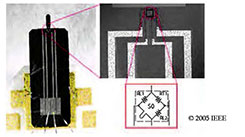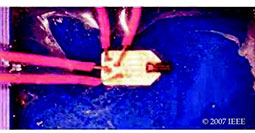
Medical device orthopedics, wireless sensors that monitor implantable medical devices, and cell research involving stem cells and platelets require highly specialized diagnostic tools and techniques. Gauges, measurement and diagnostic equipment that come into contact with body tissues and fluids may require specific properties. These may include biocompatibility, FDA approval, mechanical properties, electrical insulation, and more. Researchers at The University of Tennessee have employed EP30Med in their measurement tools and gauges for their medical device applications for its low viscosity, a non-rapid set up time, USP Class VI approval and other performance properties.
Multi-channels wireless strain mapping instrument for total knee arthroplasty with 30 microcantilevers and ACIS technology
Application
Total knee arthroplasty is a widely popular application of joint replacement. The procedure alleviates arthritic knee joint pain by capping the ends of the bones that form the joint and kneecap with metal and plastic. An invasive surgery, total knee arthroplasty addresses multiple forms of arthritic pain, including osteoarthritis (a degenerative joint disease), rheumatoid arthritis (pain due to inflammation), and traumatic arthritis (due to injury). Total knee arthroplasty resurfaces the damaged segments of the knee joint, generally following unsuccessful attempts to treat the existing bones.
To verify the success of the surgery, medical device designers created several diagnostic tools. In one such application, researchers installed strain gauges into the prosthetic component on the tibia. The gauges measure the impact on the joint by reading strain data through a strain-mapping wireless sensor array that could feed information on how the repaired joint performs following the knee replacement surgery.
Key Parameters and Requirements
Microcantilever-based sensors are the key to creating an accurate yet computationally efficient data map. Optimizing sensor quantity and size are significant challenges to the success of the application. The sensors must record accurate information without carrying a prohibitive computational cost. The sensors need to be encapsulated with medical grade adhesive to both protect them from damage and to form an appropriate interface between the implanted device and the bone tissue. Researchers tested a few epoxies1 for suitability of sensor encapsulation to select the most advantaged product to record the optimal amount of data.
Among the epoxies tested, EP30Med proved to be the best choice of the four epoxies evaluated due to several factors: its low viscosity, a non-rapid cure time, and a minimal amount of air bubbles present in the mixed epoxy during the curing process, creating a durable, homogenous consistency.
Researchers encapsulated 30 microcantilever sensors and a control article, a force sensitive resistor (FSR), in 2mm of epoxy. They then loaded both at 20µm/min.

Results
Despite initial challenges due to epoxy shrinkage, the researchers found2 that embedding microcantilever sensors in epoxy is an effective, though labor-intensive, method to create a medical monitoring device suitable for post-operative total knee arthroplasty. They cited EP30Med as the optimal epoxy choice for this application due to its low viscosity and its high-integrity cure.
Conclusions
Medical applications frequently employ EP30Med due to its low viscosity, homogeneity, optimal curing properties, and industry certifications. The epoxy is generally insensitive to the temperature and humidity of its environment and can bond various materials together without compromising joint integrity and quality.

In addition to the application referenced above, other tangential uses that employ microcantilevers would greatly benefit from using EP30Med as the adhesive/encapsulant. Food production and safety, for which the epoxy complies, high-frequency resonators, and photothermic spectroscopy are three examples of microcantilever applications that would benefit from using EP30Med.
Reference
1To, Gary; Mahfouz, Mohamed. Center for Musculoskeletal Research The University of Tennessee. Qu, Wenchao; Islama, Syed K., Department of Electrical Engineering The University of Tennessee, Knoxville, TN. Multi-channels wireless strain mapping instrument for total knee arthoplasty with 30 microcantilevers and ASIC Technology. https://www2.warwick.ac.uk/fac/sci/eng/research/grouplist/sensorsanddevi...
2Mahfouz, Mohamed; Kuhn, Michael and To, Gary. The Future of Ultra Wideband Systems in Medicine: Orthopedic Surgical Navigation. http://cdn.intechopen.com/pdfs/17467/InTech-The_future_of_ultra_wideband..., pages 307- 308.
